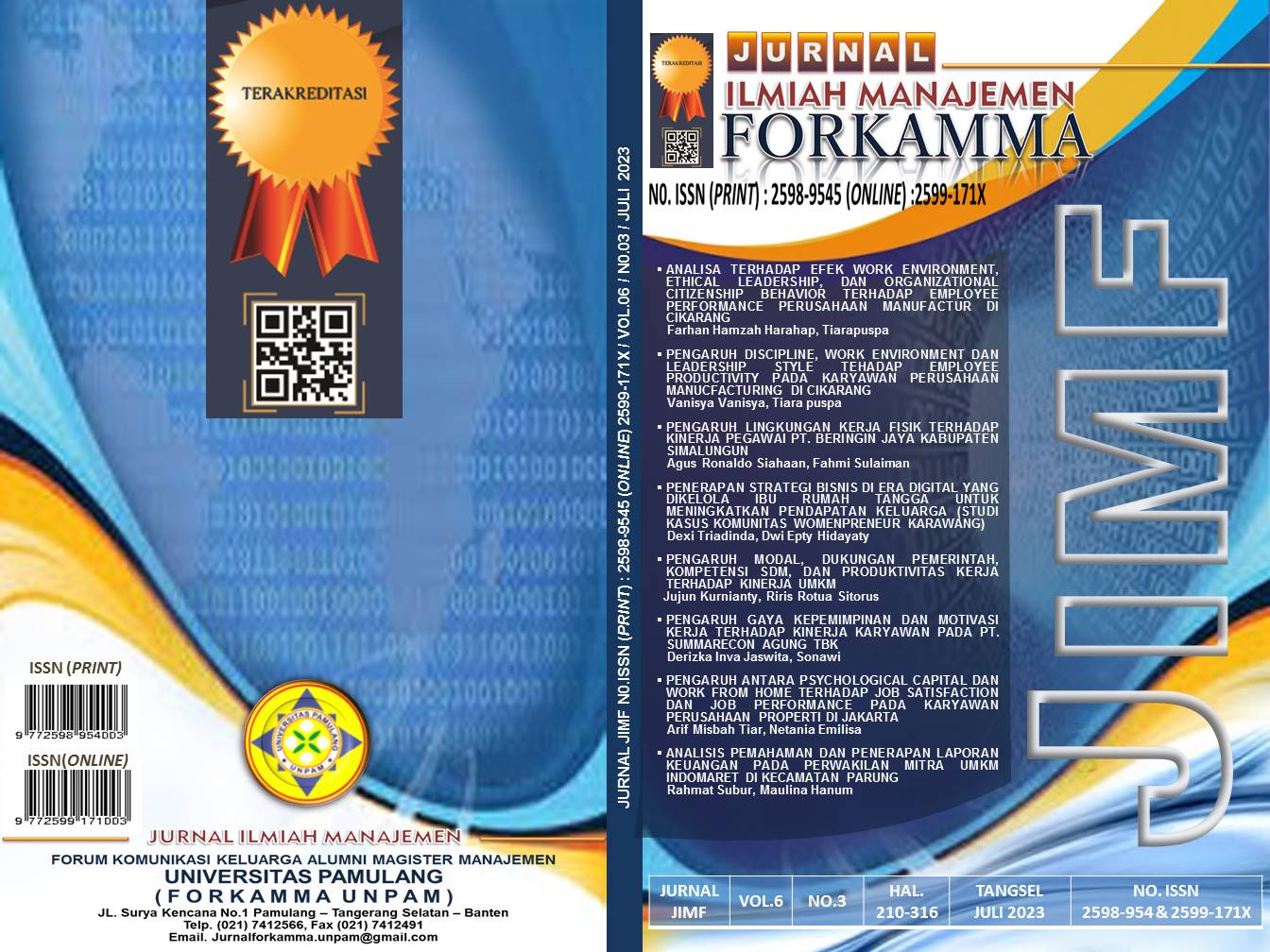Pengaruh Gaya Kepemimpinan Dan Motivasi Kerja Terhadap Kinerja Karyawan Pada PT. Summarecon Agung Tbk
DOI:
https://doi.org/10.32493/frkm.v6i3.31986Keywords:
Leadership Style, Work Motivation, Employee PerformanceAbstract
Tujuan Penelitian ini adalah untuk mengetahui bagaimana pengaruh Gaya Kepemimpinan dan Motivasi Kerja terhadap Kinerja karyawan pada PT. Summarecon Agung Tbk. Metode Penelitian ini menggunakan metode Deskriptif Kuantitatif. Analisa Data yang digunakan yaitu Uji Regresi Linier Berganda dan Uji Hipotesis. Sampel pada penelitian ini berjumlah 52 responden, teknik pengolahan data menggunakan program SPSS 26. Hasil pengujian hipotesis secara parsial variabel Gaya Kepemimpinan (X1) terhadap kinerja karyawan (Y) diperoleh nilai t hitung > t tabel yaitu 8.610 > 2.009 yang berarti terdapat pengaruh positif yang signifikan antara Gaya Kepemimpinan terhadap Kinerja Karyawan pada PT. Summarecon Agung Tbk. Variabel Motivasi Kerja (X2) terhadap Kinerja Karyawan (Y) diperoleh nilai t hitung > t tabel yaitu 9.802 > 2.009 yang berarti terdapat pengaruh positif yang signifikan antara Motivasi Kerja terhadap Kinerja Karyawan pada PT. Summarecon Agung Tbk. Secara simultan variabel Gaya Kepemimpinan (X1) dan variabel Motivasi Kerja (X2) terhadap kinerja karyawan (Y) diperoleh nilai F hitung > F tabel yaitu 57.444 > 3.19 yang berarti terdapat pengaruh yang signifikan secara simultan antara Gaya Kepemimpinan dan Motivasi kerja terhadap Kinerja Karyawan secara simultan pada PT. Summarecon Agung Tbk..
The purpose of this study was to find out how the influence of Leadership Style and Work Motivation on Employee Performance at PT. Summarecon Agung Tbk. This research method uses a Quantitative Descriptive method. The data analysis used is, Multiple Linear Regression Test and Hypothesis Test. The sample in this study amounted to 52 respondents, the data processing technique used the SPSS 26 program. The results of testing the hypothesis partially on the Leadership Style variable (X1) on employee performance (Y) obtained t count > t table or 8,610 > 2,009 which means there is a significant positive influence between Leadership Style on Employee Performance at PT. Summarecon Agung Tbk. While the results of testing the hypothesis variable Work Motivation (X2) on Employee Performance (Y) obtained t count > t table or 9,802 > 2,009 which means there is a significant positive influence between Work Motivation on Employee Performance at PT. Summarecon Agung Tbk. Then simultaneously effect of the Leadership Style variable (X1) and Work Motivation variable (X2) on employee performance (Y) obtained the F count > F table, namely 57,444 > 3.19 which means there is an influence which is significant simultaneously between Leadership Style and Work Motivation on Employee Performance simultaneously at PT. Summarecon Agung Tbk.
References
A. A. Anwar Prabu Mangkunegara. 2018. Manajemen Sumber Daya Manusia Perusahaan. PT. Remaja Rosdakarya. Bandung.
Adha Risky Nur, Nurul Qomariah, Achmad Hasan Hafidzi. 2019. Pengaruh Motivasi Kerja Lingkungan Kerja Budaya Kerja Terhadap Kinerja Karyawan Dinas Sosial Kabupaten Jember. Jurnal Penelitian Ipteks. Vol. 4 No. 1.
Afandi, P. (2018). Manajemen Sumber Daya Manusia (Teori, Konsep dan Indikator). Riau: Zanafa Publishing.
Arikunto, S. (2019). Prosedur Penelitian. Jakarta: Rineka cipta.
Azwar, S. (2019). Penyusunan Skala Psikologi. Yogyakarta: Pustaka Pelajar.
Dwiarti, R., & Wibowo, A. B. (2018). Analisis Pengaruh Tingkat Pendidikan, Kompensasi, dan Lingkungan Kerja Terhadap Kinerja Karyawan pada PT. Taman Wisata Candi Prambanan. Jurnal Perilaku dan Strategi Bisnis (JPSB), 06(02), 157–170.
Fahmi, Irham.2018. Pengantar Manajemen Keuangan. Bandung: Alfabeta. Irawati, Susan.2006. Manajemen Keuangan. Bandung: Pustaka.
G.R. Terry dalam R. Supomo dan Eti Nurhayati. 2018. Manajemen Sumber Daya Manusia. Jakarta: Penerbit Kencana.
Ghozali, I. (2018). Aplikasi Analisis Multivariate Dengan Program IBM SPSS 25 (9th ed.). Badan Penerbit Universitas Diponegoro.
Hasibuan, Malayu S. P. 2019. Manajemen: Dasar, Pengertian, dan Masalah. Jakarta: Bumi Aksara.
Herman Sofyandi. 2018. Manajemen Sumber Daya Manusia. Yogyakarta: Graha Ilmu.
Kadim, A., & Sunardi, N. (2022). Financial Management System (QRIS) based on UTAUT Model Approach in Jabodetabek. International Journal of Artificial Intelligence Research, 6(1).
Kasmir. (2018). Manajemen Sumber Daya Manusia (Teori Dan Praktik). Jakarta: Raja Grafindo Persada
Kumala, H. R., & Agustina, T. (2018). Pengaruh Gaya Kepemimpinan Terhadap Prestasi Kerja Pegawai Pada Dinas Arsip dan Perpustakaan
Lesmana, R., & Sunardi, N. (2021). Futuristic Leadership Through PEKA Analysis Approach. HUMANIS (Humanities, Management and Science Proceedings), 2(1).
Mulyadi, D. 2018. Perilaku Organisasi dan Kepemimpinan Pelayanan. Bandung: Alfbeta.
Samsudin, Sadili. 2019 Manajemen Sumber Daya Manusia. Bandung: CV. Pustaka Setia.
Sudjana. 2018. Metode Statistika. Bandung: Tarsito.
Sugiyono (2019). Metode Penelitian Kuantitatif, Kualitatif, dan R&
Sugiyono. 2018. Metode Penelitian Kuantitatif, Kualitatif, dan R&D. Alfabeta. Bandung
Sunardi, N., & Lesmana, R. (2020). Konsep Icepower (Wiramadu) sebagai Solusi Wirausaha menuju Desa Sejahtra Mandiri (DMS) pada Masa Pandemi Covid-19. JIMF (Jurnal Ilmiah Manajemen Forkamma), 4(1).
Sunardi, N., & Tatariyanto, F. . (2023). The Impact of the Covid-19 Pandemic and Fintech Adoption on Financial Performance Moderating by Capital Adequacy . International Journal of Islamic Business and Management Review, 3(1), 102–118. https://doi.org/10.54099/ijibmr.v3i1.620
Downloads
Published
Issue
Section
License
Open Access
JIMF (Jurnal Ilmiah Manajemen Forkamma) is a national peer reviewed and open access journal that publishes significant and important research from all area of agroindustry.
This journal provides immediate open access to its content that making research publish in this journal freely available to the public that supports a greater exchange of knowledge.
Copyright
Submission of a manuscript implies that the submitted work has not been published before (except as part of a thesis or report, or abstract); that it is not under consideration for publication elsewhere; that its publication has been approved by all co-authors. If and when the manuscript is accepted for publication, the author(s) still hold the copyright and retain publishing rights without restrictions. Authors or others are allowed to multiply article as long as not for commercial purposes. For the new invention, authors are suggested to manage its patent before published. The license type is CC-BY-SA 4.0.
Disclaimer
No responsibility is assumed by publisher and co-publishers, nor by the editors for any injury and/or damage to persons or property as a result of any actual or alleged libelous statements, infringement of intellectual property or privacy rights, or products liability, whether resulting from negligence or otherwise, or from any use or operation of any ideas, instructions, procedures, products or methods contained in the material therein.


